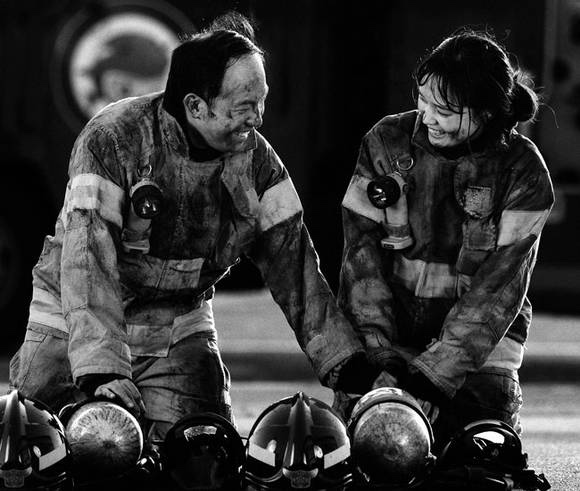Kudos to the Nation’s Unsung Heroes: Fighters of the Flames
By Chloe Chan
In June of 2021, a heartbreaking tragedy occurred at the Coupang warehouse in Incheon. A senior firefighter, Kim Dong-shik, was trapped by a fierce blaze, and his severely burnt body was later discovered in the basement. At that time, Kim was on duty rescuing people who were trapped in the building. He later failed to escape, after ensuring that everyone had been safely evacuated.
This incident is certainly disheartening. Somehow it reminds me of those tear-jerking scenes from the U.S. television series 9-1-1, and the verses from the widely known “Fireman’s Prayer”: “Whenever flames may rage, give me the strength to save some life… if according to your will, I have to lose my life, please bless with your protecting hand, my children and my wife.” Firefighters are burdened with obligations that are far beyond extinguishing fires. It is indeed a serious commitment, and a one-way track that forbids U-turns.
Due to their stability in nature, public servant (공무원) jobs are normally considered some of the most popular occupations amongst South Koreans. However, compared to the other professions that fall into this job category, firefighters might not receive as much praise, though we all recognize the potential danger of their work. On top of that, the manpower shortage experienced by many fire stations in different regions leads to inevitable long working hours.
In certain circumstances, fire stations are required to temporarily dispatch staff to other regions for emergency support. A recent example is the accident where a building collapsed in Gwangju on June 9. A building in the Nam-gu area suddenly collapsed during demolition, leaving nine people confirmed dead and eight others badly injured. Given the severity of this case, firefighters were mobilized from other fire stations across Jeollanam-do to assist local Gwangju fire stations in the search for trapped passengers in the buried bus where the collapse occurred. Metropolitan cities with larger populations like Gwangju are likely to possess better supplies and more advanced equipment than the sparsely populated regions around the city. This advantage undeniably enhances the efficiency of work in more hectic cities, but the challenges that Korean firefighters face in general are still very much unforeseen, and often cross-regional.
In Korea, each fire station normally divides firefighters into three teams. The crews are required to work in rotating shifts that are changed on a weekly or bi-weekly basis. For instance, firefighters may have a week of day shifts, and later have two weeks of night shifts – the schedule may vary depending on the region. While one is doing an “on-duty” shift, their working hours can possibly reach ten hours a day or more.

Now we might wonder what exactly the main duties of a firefighter are that would take up such long working hours. The public probably assumes that dramatic accidents, catastrophes, and other emergency situations requiring severe fires to be extinguished are not likely to happen frequently in reality; however, the duties of a firefighter are indeed way more diverse than many of us might imagine. The duties of firefighters are mainly classified into “fire”
(화재), “rescue” (구조), and “first-aid” (구급). Among these, extinguishing fires is simply part of the duties within the “fire” classification. During the past five years, 16 fires have occurred in traditional markets in Gwangju and Jeollanam-do, involving over 1.8 billion won in property damage.1
From saving people in danger and wild animals that are trapped, to relatively “minor” but very essential services such as “beehive removal,” these are all considered the most common “rescue” tasks. This summer, the average number of beehive removals reached approximately five cases per day in the rural areas of Jeollanam-do. Due to the fact that bee venom can cause life-threatening reactions and hives can cause serious structural damage to property, officials have suggested people report them immediately once they discover a beehive around the house so that the threat can be removed. As trivial as it might seem, removing a bee colony is, on the contrary, a specialized procedure that we should always leave to full-geared and well-trained professionals.
As for the “first-aid” tasks done by firefighters, they are broadly known as the basic 119 services for ambulances and fire brigades to deliver. In emergency situations, firefighters as first-aid providers administer immediate treatment such as CPR, as well as temporary care.
Rather than mere “flame fighters,” firefighters are more akin to “go-to guys” who are always reliable to tackle those unexpected troubles in our daily lives. This is indeed making the firefighter an even nobler “people’s hero” whose duties demand a rational, wholehearted devotion instead of a baseless, irrational savior fantasy. However, only since April 1 of this year have firefighters finally become “state officials” (국가직공무원) as police officers are. Taking into account that there are many anonymous heroes like Kim Dong-shik who are working day after day at their highly skilled profession to serve the community, firefighters in Korea certainly deserve much more recognition than they are ever likely to get. After all, in matters of life and death, while others turn away, they are always the ones who choose to stay.
A special thanks goes to Mr. Seong for providing firsthand information.
Images sourced from the National Fire Agency.
Source
1 Kang, E. H. (2021, October 14). 광주전남 전통시장 화재공제 미가입률 80% [Gwangju-Jeonnam traditional market no-subscription rate for fire deductions 80%]. Gwangju CMB News. http://www.cmbkj.co.kr/ab-991-22849
The Author
Originally from Hong Kong, Chloe Chan has just completed her master’s degree in NGOs at Chonnam National University. She is currently serving several NGOs and MPOs as a full-time freelancer and volunteer. Instagram @hoi0305







